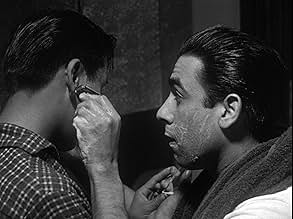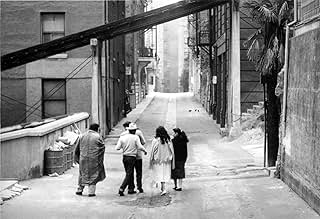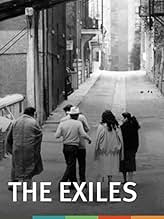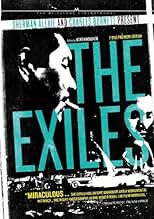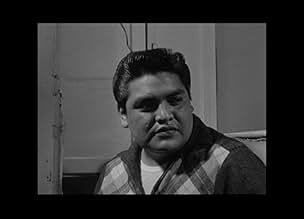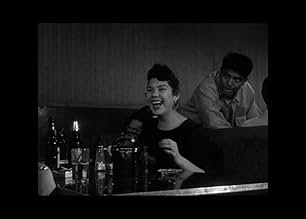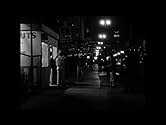IMDb RATING
6.6/10
1.5K
YOUR RATING
Follows a family of Native Americans living in the City of Angels.Follows a family of Native Americans living in the City of Angels.Follows a family of Native Americans living in the City of Angels.
- Awards
- 1 win total
Tom Reynolds
- Tommy
- (as Tommy Reynolds)
- Director
- Writer
- All cast & crew
- Production, box office & more at IMDbPro
Featured reviews
This was one of the first films to deal with the contemporary lives of Native Americans. It's still one of the very few pieces to deal with the Native urban diaspora, in this case in the no-longer existing LA neighborhood of Bunker Hill, in 1961.
More broadly, "Exiles" is a film about displacement, and finding oneself in a state of displacement, of having one's truest self be the displaced self. It focuses on a young, married couple who hardly see each other. The husband is out cavorting and fighting with other young quasi- hooligans. The wife is mostly alone, or abandoned at the cinema. The only scene where we sense that she is bonding with anybody is when she is in bed, in an officially asexual way, with a girlfriend.
As an empathetic depiction of the alienation that occurs when people are divorced from their (essentially extinct) culture, one cannot help but admire the film. Yet, I was left with the troubling sense that its depiction of characters driven to cling to each other based on the most basic similarities, such as tribe,race, and, perhaps most importantly in the eyes of the filmmakers, gender, was decidedly heteronormative. I wouldn't go so far as to call the film homophobic. The only brazenly gay characters, a couple of dudes dancing in a "straight" bar, are depicted in a neutral light. Yet, the isolation of man from woman, and "debauched" same-sex mingling are depicted as the prime symptoms of alienation under colonialism and capitalism. This attitude was all too common amid leftists in the era that the film was made.
For contemporary viewers, perhaps the most rewarding thing about The Exiles is its luscious black and white cinematography of the now destroyed Bunker Hill district of Los Angeles. As a documentary extra on the DVD further attests, Bunker Hill was a dynamic, multinational district that was home to immigrant families and retired professionals. Soon after this movie was completed, the neighborhood was bulldozed in an attempt to "improve" LA. In this way, the film seems like a depiction of two fallen cultures: the exiles of crushed Native American culture inhabiting an urban landscape that is itself now only a celluloid ghost.
More broadly, "Exiles" is a film about displacement, and finding oneself in a state of displacement, of having one's truest self be the displaced self. It focuses on a young, married couple who hardly see each other. The husband is out cavorting and fighting with other young quasi- hooligans. The wife is mostly alone, or abandoned at the cinema. The only scene where we sense that she is bonding with anybody is when she is in bed, in an officially asexual way, with a girlfriend.
As an empathetic depiction of the alienation that occurs when people are divorced from their (essentially extinct) culture, one cannot help but admire the film. Yet, I was left with the troubling sense that its depiction of characters driven to cling to each other based on the most basic similarities, such as tribe,race, and, perhaps most importantly in the eyes of the filmmakers, gender, was decidedly heteronormative. I wouldn't go so far as to call the film homophobic. The only brazenly gay characters, a couple of dudes dancing in a "straight" bar, are depicted in a neutral light. Yet, the isolation of man from woman, and "debauched" same-sex mingling are depicted as the prime symptoms of alienation under colonialism and capitalism. This attitude was all too common amid leftists in the era that the film was made.
For contemporary viewers, perhaps the most rewarding thing about The Exiles is its luscious black and white cinematography of the now destroyed Bunker Hill district of Los Angeles. As a documentary extra on the DVD further attests, Bunker Hill was a dynamic, multinational district that was home to immigrant families and retired professionals. Soon after this movie was completed, the neighborhood was bulldozed in an attempt to "improve" LA. In this way, the film seems like a depiction of two fallen cultures: the exiles of crushed Native American culture inhabiting an urban landscape that is itself now only a celluloid ghost.
Astonishing slice of cinema verite at a time when young filmmakers were trying to break the Hollywood habit in favor of the real world. The 70 minutes are not entertaining; however, they do fascinate. It's a nighttime of boozing carousal for several young Indian men amid the neon jungle of downtown LA. The camera tracks their aimless wanderings and endless drinking from one seedy venue to the next. It's LA like you've seldom seen it—a down-and-outers look at unvarnished urban decay. The faces too are fascinating, not like the usual Hollywood Indian or crowd scene extras.
It's a disturbing look, slow to accumulate until the poignant final shot. These are truly lost people, caught between two incomplete worlds-- the urban jungle of the white man and the captive reservation of the Indian. The men seem to treat most everything as a joke, perhaps a way of denying the dead-end reality of their lives. Ironically, they appear now to be strangers in their own land. It's the young Indian woman Yvonne, however, who's likely to evoke audience sympathy. It's she who dreams (her inner thoughts vocalized in voice-over) of a family and something like a normal life. But, the men in her life are truly lost, so her hopes appear doomed as well. Seeing this document may help viewers better understand the controversial American Indian Movement (AIM) of the 1970's.
Apparently, the project spanned several years of interrupted funding. Thus, the film has to be an artistic commitment of a high order on the part of filmmaker MacKenzie. Did he hope for a commercial release. A story and technique like this would seem to hold little promise of that. Did he hope for art house distribution and an appeal to the intelligentsia. Whatever the motivation, he's produced a document of lasting social value, and thanks be to TMC for bringing MacKenzie's achievement to today's audiences
It's a disturbing look, slow to accumulate until the poignant final shot. These are truly lost people, caught between two incomplete worlds-- the urban jungle of the white man and the captive reservation of the Indian. The men seem to treat most everything as a joke, perhaps a way of denying the dead-end reality of their lives. Ironically, they appear now to be strangers in their own land. It's the young Indian woman Yvonne, however, who's likely to evoke audience sympathy. It's she who dreams (her inner thoughts vocalized in voice-over) of a family and something like a normal life. But, the men in her life are truly lost, so her hopes appear doomed as well. Seeing this document may help viewers better understand the controversial American Indian Movement (AIM) of the 1970's.
Apparently, the project spanned several years of interrupted funding. Thus, the film has to be an artistic commitment of a high order on the part of filmmaker MacKenzie. Did he hope for a commercial release. A story and technique like this would seem to hold little promise of that. Did he hope for art house distribution and an appeal to the intelligentsia. Whatever the motivation, he's produced a document of lasting social value, and thanks be to TMC for bringing MacKenzie's achievement to today's audiences
The premise is simple-we follow a group of young, modern day Native American men and women in Los Angeles over 24 hours. We experience their daily rituals, conflicts, and pleasures, and, for the most part, I found this rather simple film to be highly interesting. Although it remains virtually plot less throughout, there are some moments of conflict and surprising intensity that save it from being "boring" or overly mundane. The tragedies as well as the comedies of life are explored, as personalities, feelings, and opinions are revealed and studied.
The highlights of the film are the dazzlingly beautiful voice over sequences, in which a random character will voice their perspective on their way of life or their friends or their hopes and aspirations, and so on. They transform the every man into a wise and lovable poet. We understand and learn about our characters more and more not only through their subtle actions, but also their words and ways of communicating.
However, there are moments of boredom here. I think this movie would have worked better as a lengthy short film that would be, say, 35-40 minutes long. That would be perfect. Either that or a little bit more conflict or humor or just flat out interesting events.
The highlights of the film are the dazzlingly beautiful voice over sequences, in which a random character will voice their perspective on their way of life or their friends or their hopes and aspirations, and so on. They transform the every man into a wise and lovable poet. We understand and learn about our characters more and more not only through their subtle actions, but also their words and ways of communicating.
However, there are moments of boredom here. I think this movie would have worked better as a lengthy short film that would be, say, 35-40 minutes long. That would be perfect. Either that or a little bit more conflict or humor or just flat out interesting events.
10Mackzee
"The Exiles" was made on a shoe-string budget by a number of idealistic young film-makers "led" by Kent Mackenzie as "writer/director/editor.
Mackenzie and his crew were dismayed (putting it lightly)by what they saw as a lack of use of film as an artistic medium. At the same time the standard "Hollywood" aesthetic sacrificed subject, in order to obtain perfect/yet unrealistic lighting schemes, camera movement, framing and pristine sound tracks.
Erik Daarstad, John Morrill and Bob Kaufman shot an incredibly striking 35mmm B&W film. It is truly stunning. And a testament to all involved.
"The Exiles" is phenomenal in that, Mackenzie agreed not to put anything in the film that "the actors" objected to in any way. Appropriately, but very unusual, the "voice" in the film is that of the subjects.
"The Exiles" is of a specific time: a Los Angeles that literally no longer exists. And it is timeless, in the questions it asks and in it's gut wrenching portrayal of a particular group of individual's lives. Lives that unfortunately could/and do exist as I write this almost 50 years later.
Mackenzie credits the viewer with the intelligence to relate to the human condition as seen on screen. And explore for one's self how we fit into a world in which these conditions exist. We aren't forced to listen to the traditional "voice of god" voice over that dehumanizes all involved in the experience.
Sadly, Kent Mackenzie died young in May of 1980. He made relatively few films. Yet, "The Exiles" and his USC student film: "Bunker Hill" (made with Robert Kaufman) spoke to a bright young artist who worked with an integrity few possess.
If one has the opportunity to see this film as it should be, in a theater on a 35mm print. It is well worth the time. And an experience which will stay with you from that day forward.
Mackenzie and his crew were dismayed (putting it lightly)by what they saw as a lack of use of film as an artistic medium. At the same time the standard "Hollywood" aesthetic sacrificed subject, in order to obtain perfect/yet unrealistic lighting schemes, camera movement, framing and pristine sound tracks.
Erik Daarstad, John Morrill and Bob Kaufman shot an incredibly striking 35mmm B&W film. It is truly stunning. And a testament to all involved.
"The Exiles" is phenomenal in that, Mackenzie agreed not to put anything in the film that "the actors" objected to in any way. Appropriately, but very unusual, the "voice" in the film is that of the subjects.
"The Exiles" is of a specific time: a Los Angeles that literally no longer exists. And it is timeless, in the questions it asks and in it's gut wrenching portrayal of a particular group of individual's lives. Lives that unfortunately could/and do exist as I write this almost 50 years later.
Mackenzie credits the viewer with the intelligence to relate to the human condition as seen on screen. And explore for one's self how we fit into a world in which these conditions exist. We aren't forced to listen to the traditional "voice of god" voice over that dehumanizes all involved in the experience.
Sadly, Kent Mackenzie died young in May of 1980. He made relatively few films. Yet, "The Exiles" and his USC student film: "Bunker Hill" (made with Robert Kaufman) spoke to a bright young artist who worked with an integrity few possess.
If one has the opportunity to see this film as it should be, in a theater on a 35mm print. It is well worth the time. And an experience which will stay with you from that day forward.
10muputony
Kent Mackenzie, USC Filmmaker, follows one 24 hr day of a native american couple and their friends in downtown Los Angeles, CA on & near Bunker Hill. With flashbacks to reservation life, the pathos of the "non-BIA approved" urban Indian life of poverty and utter hopelessness will move you beyond mere words. Homer & Yvonne are expecting a child - he is distant and lost, she abjectly passive and accepting of her fate. Absolutely real and so personal you may cry, knowing that nothing is going to get any better, and wishing that you could reach across time to make it different. Their child will be born in 1961-2 and is now age 40 if s/he survived.
Kent also made a film, "Bunker Hill" which followed an aged Doctor on his visits to patient's homes located on Bunker Hill area in Los Angeles where Homer & Yvonne lived. Scenes of Angel's Flight and old victorian buildings are in both films. Lost times and places now covered with corporate headquarters. Two American Tragedies.
Kent also made a film, "Bunker Hill" which followed an aged Doctor on his visits to patient's homes located on Bunker Hill area in Los Angeles where Homer & Yvonne lived. Scenes of Angel's Flight and old victorian buildings are in both films. Lost times and places now covered with corporate headquarters. Two American Tragedies.
Did you know
- TriviaKent Mackenzie borrowed equipment from industrial film makers Parthenon Pictures and used the unused "ends" of thousand-foot reels of 35mm film, according to an article in the 12 March 1961 edition of the New York Times.
- GoofsIn a scene where an older man is heard singing and playing an instrument under a tree, he is not doing corresponding actions in a long-shot.
- ConnectionsFeatured in Los Angeles Plays Itself (2003)
- How long is The Exiles?Powered by Alexa
Details
- Release date
- Country of origin
- Official site
- Language
- Also known as
- Изгнанники
- Filming locations
- See more company credits at IMDbPro
Box office
- Budget
- $539 (estimated)
- Gross US & Canada
- $30,945
- Opening weekend US & Canada
- $8,448
- Jul 13, 2008
- Gross worldwide
- $30,945
- Runtime
- 1h 12m(72 min)
- Color
- Sound mix
- Aspect ratio
- 1.37 : 1
Contribute to this page
Suggest an edit or add missing content


